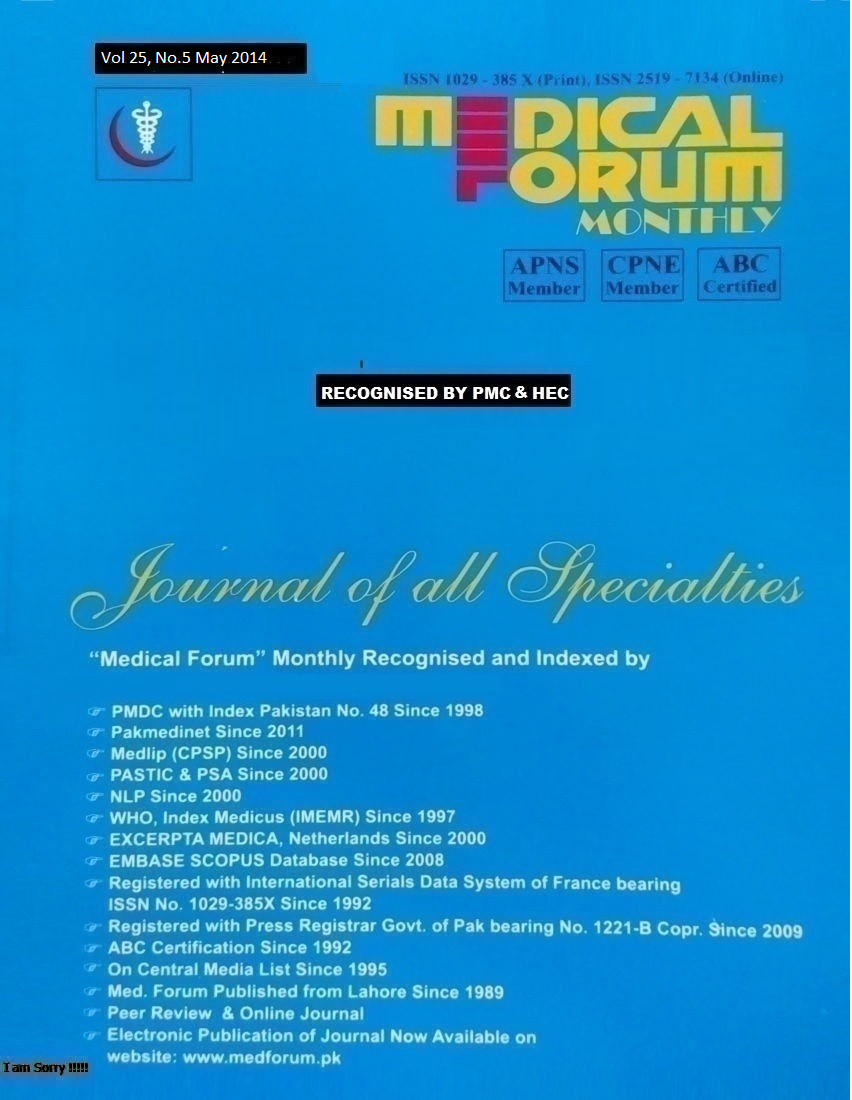
1. Evaluation of Nacked Eye Single Tube Red Cell Osmotic Fragility Test for Screening of Beta Thalassaemia Trait
1. Farzana Chang 2. Mir Mohammad Sahito 3. Riaz Ahmed Qazi
1. Assoc. Prof. of Pathology, LUMHS, Hyderabad 2. Assoc. Prof. of Forensic Medicine, Muhammad Medical College, Mirpur, Sindh 3. Assoc. Prof. Pathology, PUM&HSW, Nawabshah, Shaheed Benazirabad.
ABSTRACT
Objective: The study aimed to evaluate the validity and significance of Nacked Eye Single Tube Red cell Osmotic Fragility Test (NESTROFT) for screening of beta thalassaemia trait (BTT) to reduce the incidence of birth of thalassaemic child in community. Study Design: Cross sectional study
Place and Duration of Study: This study was conducted at Diagnostic and Research Lab in Pathology Department of Peoples University of Medical Health Sciences (PUMHSW) at Shaheed Benazirabad from January 2013 to December, 2013.
Materials and Methods: Total 504 subjects comprising 303 (60.3%) females and 201(39.7%) males with age ranging between 5 and 48 years and male to female ratio 1:1.5 were selected for this study. The family history of thalassaemia and history of cousin marriages were noted. EDTA anti-coagulated whole blood samples were collected for on-site NESTROFT testing, and later tested for Complete Blood Count (CBC) and serum Ferritin concentration at Diagnostic and Research Laboratory of Pathology Deptt. PUMHS. Screening for BTT was done on Naked Eye Single Tube Red cell Osmotic Fragility Test (NESTROFT) with 0.36% freshly prepared saline. The diagnosis of BTT was confirmed on automated Hemoglobin Electrophoresis at cellulose acetate alkaline pH. Red cell indices (automated Hematology cell counter cell-tac alpha) were assessed along with peripheral smear morphology (Leishman’s stained slides) as enhanced tool for BTT case finding.
 Results: Out of total 504 subjects 201 married women and 101 married men with their mean age (26.5 + 21.5) years were selected. In this study, female to male ratio was 1.5:1 and among the total 302 married subjects, ratio of cousin marriages (60.4%) was noted. Neither any women were pregnant nor there was history of thalassaemia in their families. The laboratory parameters such as the mean values of hemoglobin g/dl, RBC count millions/cmm, PCV %, MCV fl, MCH pg, MCHC g/dl among these subjects respectively were 11.9 g/dl, 4.5 millions/cmm, 82 fl, 38.7%, 26.9 pg, 33.2 g/dl. Out of 504 samples, NESTROFT was positive in 21 (4.1%) and negative in 483 (95.9%). Out of all NESTROFT positive cases 15 (71.4%) were true positive confirmed on the hemoglobin electrophoresis with increased hemoglobin A2 level above 3.5 and remaining 6(28.6%) were false positive. Only 4 (1%) cases were false negative, then sensitivity, specificity, positive and negative predictive values and efficiency of NESTROFT were calculated 87%, 86%, 71%, 99% and 99.9 respectively.
Results: Out of total 504 subjects 201 married women and 101 married men with their mean age (26.5 + 21.5) years were selected. In this study, female to male ratio was 1.5:1 and among the total 302 married subjects, ratio of cousin marriages (60.4%) was noted. Neither any women were pregnant nor there was history of thalassaemia in their families. The laboratory parameters such as the mean values of hemoglobin g/dl, RBC count millions/cmm, PCV %, MCV fl, MCH pg, MCHC g/dl among these subjects respectively were 11.9 g/dl, 4.5 millions/cmm, 82 fl, 38.7%, 26.9 pg, 33.2 g/dl. Out of 504 samples, NESTROFT was positive in 21 (4.1%) and negative in 483 (95.9%). Out of all NESTROFT positive cases 15 (71.4%) were true positive confirmed on the hemoglobin electrophoresis with increased hemoglobin A2 level above 3.5 and remaining 6(28.6%) were false positive. Only 4 (1%) cases were false negative, then sensitivity, specificity, positive and negative predictive values and efficiency of NESTROFT were calculated 87%, 86%, 71%, 99% and 99.9 respectively.
Conclusion: The NESTROFT is a valuable, cost effective screening test for beta thalassaemia trait.
Key Words: Beta thalassaemia trait (BTT), Nacked eye single tube red cell osmotic fragility test (Nestroft),
Screening.
